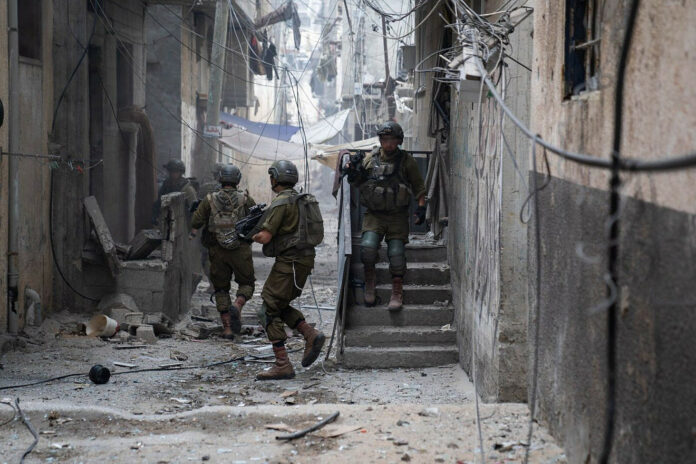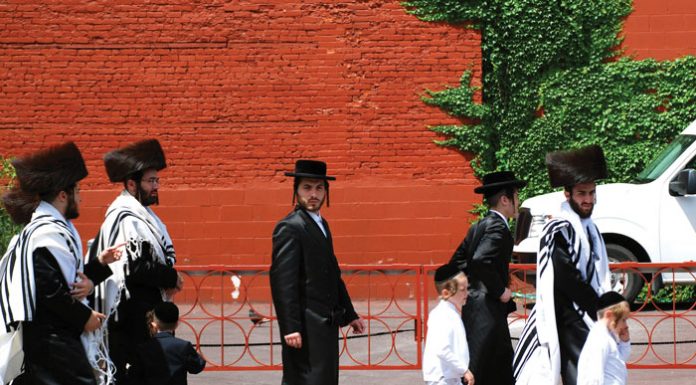I extricate myself with difficulty from the armored humvee and steady my feet on the muddy ground of the terrain, stretching my limbs after a bumpy ride in the military vehicle. A gray sea of destruction surrounds me, with ruins visible as far as the horizon. In the background, the thunderous sounds of explosions reverberate, and the ground trembles beneath our feet.
“Where’s the frontline?” I ask Erez, the officer at my side, standing tensely with his rifle ready to fire. “The frontline?” he repeats. He gestures vaguely to the north, the east, the south, the west. “Over there.” Then he points upward. “Up there, too, and down there,” he motions to the ground beneath our feet. The battle is everywhere.
We’re standing in the heart of Gaza City, to the west of the Shati refugee camp and the westernmost point of the area of Hamas’ command center, with al-Shifa Hospital at its center. All around the area are scattered tanks, APCs (armored personnel carriers) and columns of soldiers who tread carefully through the ruins. Slowly, gradually, I identify positions from which green helmets poke out, along with rifle tips. Snipers emerge on the rooftops of several buildings and from behind us comes the rattle of mortar fire. “We have to be constantly on the lookout and ready to fire at any moment,” says Erez. “We’ve cleared the area, but the enemy could still pop up anywhere.”
INTO THE GAZA MIRE
We waited for quite a while to cross the border into Gaza. The road is full of potholes and crowded with soldiers, and we get into a military vehicle, accompanied by soldiers from the Kfir Brigade. They face outward, their guns aimed into the distance, ready to fire. “If something happens,” Yossi, the commander of the vehicle and the one responsible for the entire convoy, tells me, “you’ll duck down, as low as you can get.” A not entirely reassuring introduction, but he continues, “Of course, nothing might happen, and I hope that everything will be fine. But that’s the procedure.” Thanks.
The group in the vehicle is very mixed. Einav is a young man, virtually a boy, with an innocent gaze, his helmet too large on his head. He’s learning Computer Science at the University of Haifa. Uri comes from a town near Ashkelon, and Yossi is a religious young man who was born in New Jersey; he’s the one responsible for the mounted machine gun. He starts by murmuring tefillas haderech on behalf of us all. They are all kitted up from head to toe, outfitted with armor, weapons and ammunition.
We enter the area via a breach the terrorists made in the fence, near Zikim. Yossi relates that he doesn’t take his gaze off the road for a moment, and how the first time he entered Gaza, there were still bodies scattered along the route, between the border fences—bodies of terrorists and of Israelis who had been abandoned by them.
Soon the view changes from open fields to the buildings of the crowded neighborhoods of Gaza, and the scenery becomes urban and congested. The road we’re driving along runs parallel to the coastline and has, for good reason, become the main entranceway to Gaza. Although it does not border Israeli territory, it provides a partial defensive line to the entering soldiers, as they know there are no enemies to their west, from the sea. For added security, the IDF doesn’t use the part of the coastal road that’s called the A-Rashid road, which is full of IEDs and booby-traps. The entire coastal region of Gaza is in ruins, and we pass bulldozers used to shift the debris of the shattered buildings in order to open the road to IDF traffic. The sides of the road are lined with heavy earthen embankments piled up to add a layer of protection to the Israeli military.
There’s a great deal of traffic along this road; military vehicles travel back and forth on it all the time. “Sometimes,” notes Yossi, “there are traffic jams, which are especially dangerous here, so we try our best to prevent any static situation from developing. We are always on the alert, because terrorists can still emerge from among the ruins. The greatest danger is here,” he adds, “from anti-tank fire. Terrorists can hide between the ruins and fire at us without warning. The earthen embankments that we’ve piled up at the sides of the road provide us at least with some cover.”
To read more, subscribe to Ami





















